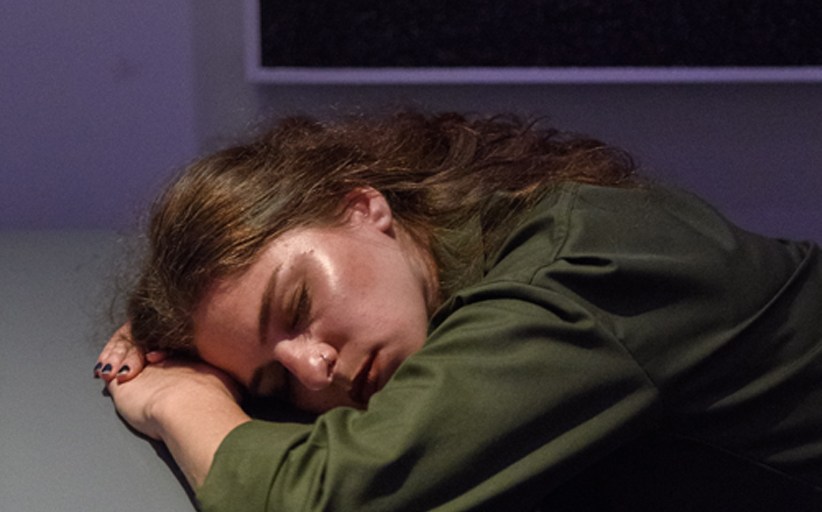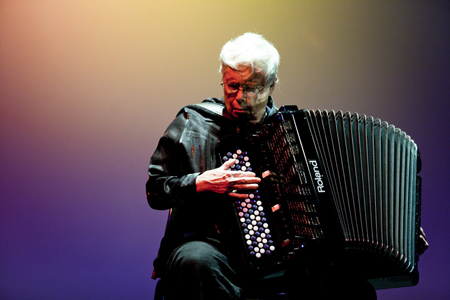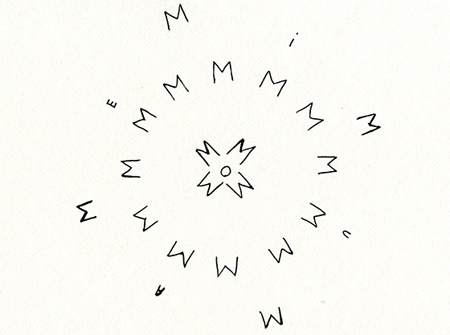


How does the way you hear sound influence your understanding of the world around you? This question guided the life’s work of groundbreaking artist Pauline Oliveros, who died in 2016. Oliveros, whose work was featured in the Rubin Museum’s exhibition The World Is Sound, left behind a rich legacy of innovative techniques intended to shift the way we experience the act of listening.
The practice she developed, Deep Listening, is designed to improve a practitioner’s sonic awareness, with the potential to increase creativity, enhance openness and compassion, and expand overall consciousness. Deep Listening techniques continue to inspire new generations of sound makers and artists of all types, but nearly everyone (artist or not) can employ the practices and attempt to transform their minds.

Photograph by Vinciane Verguethen
We invite you to try the Deep Listening techniques below, which Oliveros called Sonic Meditations. For more information on Pauline Oliveros and Deep Listening, visit The Center for Deep Listening.
1. Are you listening now?
2. Are you listening to what you are now hearing?
3. Are you hearing while you listen?
4. Are you listening while you are hearing?
5. Do you remember the last sound you heard before this question?
6. What will you hear in the near future?
7. Can you hear now and also listen to your memory of an old sound?
8. What causes you to listen?
9. Do you hear yourself in your daily life?
10. Do you have healthy ears?
11. If you could hear any sound you want, what would it be?
12. Are you listening to sounds now or just hearing them?
13. What sound is most meaningful to you?
Dedicated to Amelia Earhart
Any number of persons sit in a circle facing the center.
Illuminate the space with dim blue light. Begin by simply observing your own breathing. Always be an observer. Gradually allow your breathing to become audible.
Then gradually introduce your voice. Allow your vocal cords to vibrate in any mode which occurs naturally. Allow the intensity of the vibrations to increase very slowly.
Continue as long as possible, naturally, and until all others are quiet, always observing your own breath cycle.
Variation: translate voice to an instrument.

Oliveros used this icon of a circle with a dot in the center to symbolize the relationship of attention (the dot) to awareness (the circle).
Begin by taking a deep breath and letting it all the way out with air sound. Listen with your mind’s ear for a tone.
On the next breath using any vowel sound, sing the tone that you have silently perceived on one comfortable breath.
Listen to the whole field of sound the group is making.
Select a voice distant from you and tune as exactly as possible to the tone you are hearing from that voice.
Listen again to the whole field of sound the group is making.
Contribute by singing a new tone that no one else is singing.
Continue by listening then singing a tone of your own or tuning to the tone of another voice alternately.
Commentary:
Always keep the same tone for any single breath.
Change to a new tone on another breath.
Listen for distant partners for tuning.
Sound your new tone so that it may be heard distantly.
Communicate with as many different voices as possible.
Sing warmly!
Stand together in a circle with feet about shoulder-width apart and knees a little soft.
Warm up your hands by rubbing palms together until you feel the heat.
Place your right hand over your own heart. Place your left hand on the back of your left hand partner (back of the heart).
After a few natural breaths sing/chant/intone “AH” on any pitch that will resonate your heart. Sense the energy of your own heart and that of your partner over the course of several breaths.
Can you imagine that the heart energies are joining together for healing yourself and others?
Can you imagine heart energies traveling out into the universe as a healing for all victims and toward the end of violence?
When The Heart Chant ends, gradually release your palms and bring them forward parallel in front of you. Sense the energy between the palms as if there were a sphere or ball that can be moved around. Then bring your palms to your own center, fold them over and store the energy.

Lullaby for Daisy by Pauline Oliveros.
All of the meditations included here are by Pauline Oliveros. Reprinted with permission from Pauline Oliveros Trust, 2017.

Rubin Museum
150 W. 17th St., NYC
Get the latest news and stories from the Rubin, plus occasional information on how to support our work.